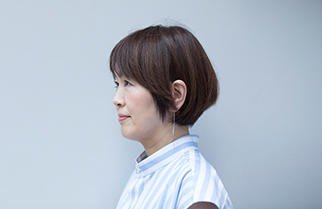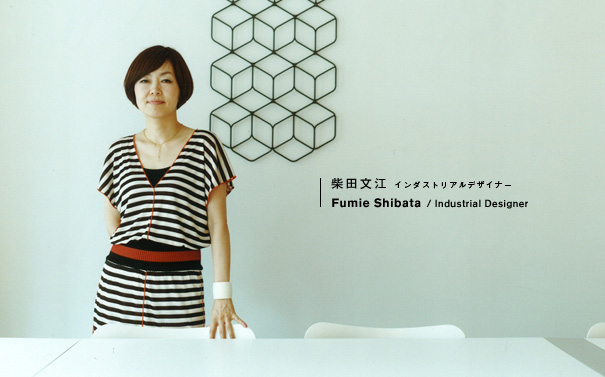
03 Fumie Shibata (Industrial Designer)

- JP / EN
Fumie Shibata, winner of the 2011 Mainichi Design Award, is one of Japan's top industrial designers. She is deeply involved with Tokyo Midtown, serving as judge for the "Tokyo Midtown Award" - an art and design competition now in its fifth year - and participating in exhibitions at Tokyo Midtown Design Hub. Shibata also has her office in Roppongi. We asked her for ideas to transform Roppongi into an area of design and art.
Designs are all around us
To turn Roppongi into a city of design and art, I would plan design workshops or experience-oriented events. I want people to become more aware that designs are all around us.
I think the act of personally incorporating design helps us to become civilized, and to appreciate our everyday lives. So I would hold workshops or events where people can think to themselves, "I had quite a fun time today." Then perhaps later on, after some time has passed, they will look at something and realize "Oh, so that's what design is all about." It would be nice if I could create opportunities for people to deepen their understanding in that way.
Design is something that is inextricable from the lives of everyone. If people could experience art as being part of their everyday lives, their horizons will expand.
Design and Art help to enrich our everyday lives
There's a tendency for design and art to be claimed by grown-ups and experts, but I think for Roppongi to become an area of design and art, the key lies with the children and the families and the people who come here for leisure. It's important that these people feel close to design and art and see this area as a place that makes their daily lives richer.
In that sense, I think Tokyo Midtown has a big role to play. A wide range of people come here, from children to the elderly. The appeal of Tokyo Midtown is that expertise and professionalism exist alongside the very ordinary, day-to-day life.
Five years have passed since I moved my office to Roppongi. I go almost every day to Tokyo Midtown and it is part of my living area. For lunch, there are many places to choose from such as the Chinese restaurant "Fuan Long Yuen" which is famous for its mango puddings and the pizzeria "Napule". There's also the Tonkatsu at "Hirata Bokujo", and the fish at "Suzunami". I know quite a lot about these establishments. (laughs)
Since I'm always going to these places, I take them for granted, but the other day I went to Harajuku which I haven't visited for a while, and on my way home, I dropped by Tokyo Midtown, and realized once again what an extraordinary place it is.
The uniqueness of Tokyo Midtown
I feel that people who come to Tokyo Midtown have a strong interest in clothes and personal items, and take a serious attitude toward how they spend their everyday lives. Since Tokyo Midtown is where all these people come together, it would be good if more information could come out from this place. I suppose you could try many different ways, but I think the essential thing is to "deepen" what is already taking place. There are things that the whole town of Roppongi has already put efforts in. In Tokyo Midtown, for example, there are events like the "Roppongi Art Night" and the "Tokyo Midtown Award" competition. I think the content of these events should be deepened. You should also let more people know about them. It's not a flashy thing to do, but I feel it's the most important thing that can be done to transform Roppongi into an area of design and art.
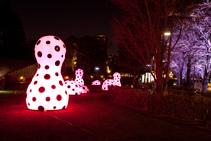
"Roppongi Art Night 2012" was held in March 2012, bringing together the community of the Roppongi area, including the art museums and the community of the shopping districts. Yayoi Kusama's works were exhibited all over Roppongi. Some of them are shown in the photograph.

People are now searching for what is most appropriate
When creating a new establishment, I think it's important to avoid making anything new that is not appropriate. At the same time, we should keep on sorting things out and discard what we don't need. Take lighting, for example. We might still feel that brighter is better, or that items made overseas are more stylish. We are still stuck with some values. But when we take a good look at something, it often turns out that it doesn't really suit us right now. So we need to shake off these fixed values and sort things out based on new, personal criteria. This paves the way to the future.
There used to be a time when people thought of design as being things that looked elaborate and appreciated them, but those values are passé now. When building a facility, there is no point trying to outdo another new facility under construction by making yours more and more excessive. I think we need to become a little more fundamental. I feel everyone is now searching for what is most appropriate - what is best for us in our circumstances.
Taking many factors into account and not losing sight of the essentials
In that aspect, I think Tokyo Midtown is one of the places in Tokyo right now where things have been sorted out to a certain extent. While there are some luxurious elements, they don't give the impression of excessiveness. The materials and things that are used are genuine and give satisfaction. You get the sense that the buildings and the general design of everything is of a quality that is very appropriate. I'm not saying this to be polite. I really mean it. Also, there are Japanese-style factors that are not too modern, and they are not imitations of anything or nostalgic of the past. Everything is exquisitely "just right."
For me, that is what design is about. Making something for only the people who understand what you are doing is probably the easy thing. To make something for a place where a lot of people gather, or where many factors have to be taken into account - and to do it in the most appropriate way while not losing sight of the essentials - is a task that is very difficult but very important. I wish that more people would look at Tokyo Midtown and learn from it. It would be great if more buildings and public facilities could be built in the way Tokyo Midtown has been built.
Minato city's "Declaration to utilize design resources"
While we are on the subject of making a town of design and art, I should mention that in 2008, Minato city (municipal authorities of Roppongi area) adopted a "Declaration to utilize design resources." There are many design-related offices in Minato city and plenty of designers, and the plan is to make use of these resources. I am a member of this project, and through the contacts I have there, I was asked by the community of the Roppongi shopping district to make a flowerbed at the Roppongi intersection.
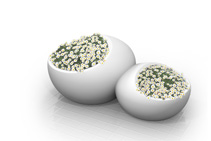
The "smiley x smiley" flowerbeds that Fumie Shibata designed for the Roppongi intersection, where tens of thousands of people pass by, are of gentle, rounded form.
Art directors Keisuke Nagatomo and Kasai Kaoru are also members of this project. Designers all have a wish to improve the neighborhood they live in. And if someone is going to make something weird and make the place look weird, they would rather do it themselves. (laughs)
I think the community of the Roppongi shopping district is the best of all the shopping district communities in Minato city. The Roppongi shopping district cooperates with both Tokyo Midtown and Roppongi Hills, and since everyone is proud of the town, it's a cohesive community.
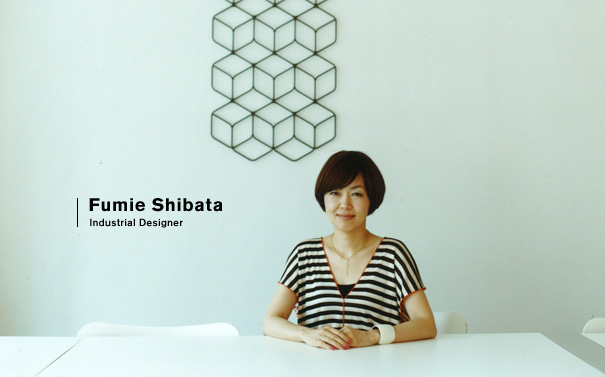
Of all the cities in the world, I like Tokyo best
Tokyo is chaotic, with so many things messily mixed up, but of all the cities in the world, I like Tokyo best.
I'm from Yamanashi Prefecture. My home is located roughly midway between Lake Yamanaka and Lake Kawaguchi. My first experience of Tokyo was when I was in third-grade at elementary school. I came with a friend to shop in Harajuku. It was a great adventure for me then. In my childhood, things were not available all across Japan as they are now. For example, if there were rumors that legwarmers were the craze, we had to go to Tokyo to buy them. And when I came back with them, I was a hero. Classmates would say, "Wow, you've got that!" and I became a bit of a fashion leader at the elementary school.
Now that I'm an adult, Tokyo is no longer the city of my dreams, but what I love about it is the freedom. When I am abroad, I find that the restaurants for meals and the places for leisure are clearly segmented. In Tokyo though, whether you are a child or a grownup, you have the freedom of choosing from numerous options.
Swimming like a shark in the middle of a fast current
I decided to have my office in Roppongi because it's at the center of Tokyo. Nowadays, the center is not necessarily the ideal place to work in, but for me, to be working at the center is good because a lot of things flow in. So I want to stay here as long as circumstances allow.
I've heard that in the ocean, there are sharks where the current is fast because a fast current allows them to breathe through their gills even when they are resting. It's important to take your own action, but I understand how the sharks feel.
As a designer, what interests me most at the moment is Japan's great technology in the sciences. I'm currently working with a chemical manufacturer which has, to put it simply, a new technology to make things which do not feel like matter. It's a technology that could drastically change the way things are. I'm excited to be reminded that Japan has such high levels of technology.
The potential in creating things
With this new, magic-like technology, the question arises as to how we could make it useful in our everyday lives, by merging it with design.
I once heard that new discoveries are made when people with totally different values work toward the same goal. I never had the opportunity to meet researchers before and I very much enjoy talking to them now. Sometimes we meet at my Roppongi office and the researchers in turn seem to be intrigued with this (designers') world. (laughs) But the researchers are truly creative and I'm often surprised at how strong their design literacy is. In Japan, there is the marvelous method of making things through traditional craftsmanship, but apart from that, there is the method of making things in a scientific way. I think that with the latter, there is still a lot of potential for us to jump higher.
Editor's thoughts
Shibata-san gave many examples that were easy to understand, and I found myself nodding constantly as I listened to her. Shibata-san knows the local scene well since her office is close to Tokyo Midtown, and after the interview, she told us about various nice spots including restaurants we should go to for lunch. The places she recommended are mentioned in the editor's blog. (edit_rhino)




